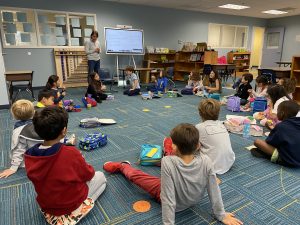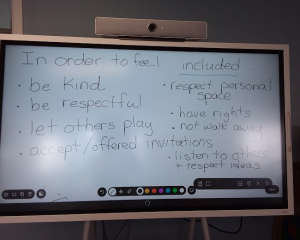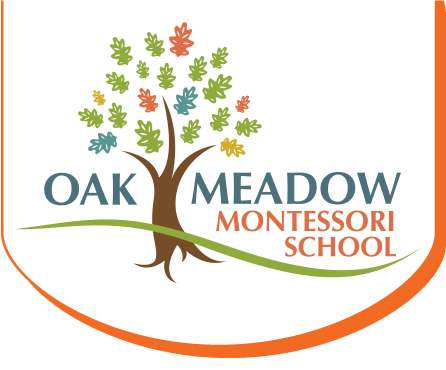Students are engaged in a dynamic conversation with their teacher, as they sit in a circle during the classroom morning meeting. They are eager to jump into the conversation. Hands shoot into the air. Students take turns listening to each other and sharing their own ideas, while the teacher takes notes on a large, digital display.
 The students are taking part in the work of creating a “classroom charter,” something that is done in every classroom at Oak Meadow. Last week the class agreed on six words that described how they wanted to feel: Peaceful, Happy, Helpful, Playful, Respected, and Included.
The students are taking part in the work of creating a “classroom charter,” something that is done in every classroom at Oak Meadow. Last week the class agreed on six words that described how they wanted to feel: Peaceful, Happy, Helpful, Playful, Respected, and Included.
This morning the students are focusing on the next step. The students must come to a shared agreement about what they will do each day, over the entire school year, so that everyone in the class experiences all of these feelings. Today they are focusing on what they will do so that others feel “included.”
Three students suggest what actions and words will help others feel included: “be kind,” “be respectful,” and “let others play.
The teacher asks, “What do you mean by letting others play? What words might you use to express this idea? What if you used the word ‘invitation.’ What does it mean to get an invitation?” Students discuss this. They agree that in order to feel included, students will “accept and offer invitations.” The teacher reminds students, “You can also ask to play, you don’t have to wait until someone offers you an invitation. She adds the final wording to the display board “accept and offer invitations.”
A student shares another idea: “respect personal space.” The teacher agrees, “Everyone needs space sometimes. Respect is the key.” And the teacher adds this to the list.
 “Understand that all of us have rights,” one student suggests. “What do you mean when you say ‘rights’?” One student chimes in, “don’t walk away when people are talking with you.” The teacher responds, “Okay, how can you express that idea using positive words?” Students answer… “listen to others” and “respect their ideas.” The teacher builds on that, “We all have different ideas. When we get together, we need to listen to each other.” The teacher then adds “listen to others and respect their ideas” to the list.
“Understand that all of us have rights,” one student suggests. “What do you mean when you say ‘rights’?” One student chimes in, “don’t walk away when people are talking with you.” The teacher responds, “Okay, how can you express that idea using positive words?” Students answer… “listen to others” and “respect their ideas.” The teacher builds on that, “We all have different ideas. When we get together, we need to listen to each other.” The teacher then adds “listen to others and respect their ideas” to the list.
The class charter is created in a way that enables it to be a living document — it’s something that students talk about regularly all year long, and students come to rely on it when they think about how to have positive relationships with each other. Students are involved in making the charter, so they have ownership of the process. They become invested in the idea of creating the best classroom environment for themselves personally and for each other. And when mistakes are made, everyone knows that there will be a process for making amends if another student feels disrespected or hurt.
Teachers and staff also have created a charter together, called the employee charter. Some parents have adopted the practice of creating a family charter at home. When these practices become deeply ingrained and habitual, it has the effect of creating a more positive and healthy culture school-wide, and that’s the larger purpose and goal worth accomplishing.





